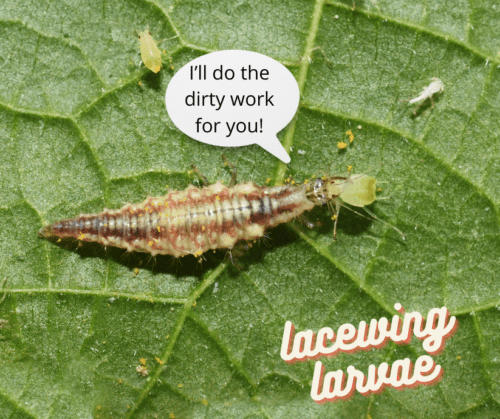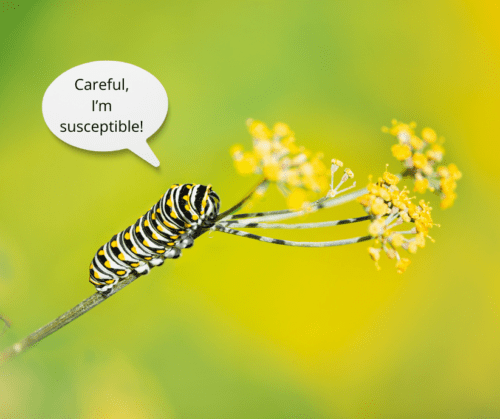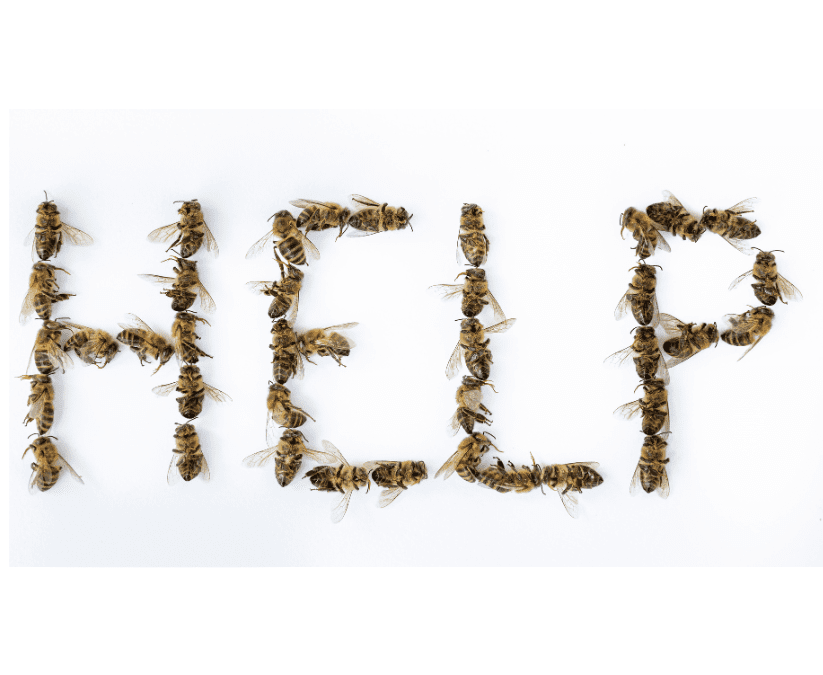Today is Earth Day, and with May being right around the corner, I felt the need to write about the delicate balance of controlling garden pests and protecting our local wildlife and essential pollinators.
May is generally the month that pest activity begins to increase in our San Antonio gardens. When the weather warms up, the pests emerge. Will this be the year that you opt to let nature run its course? What I mean is, will you run to the store for a “wipe out” spray at the first sign of pests, or will you take the time to identify the problem? Will you choose the least toxic control method which might simple manual control, or would you choose to do nothing at all? Don’t freak out yet, hear me out.

Manual Control for Pests and Beneficial Insects
You might be amazed at how simple but effective some of these methods are. A hard blast of water can dislodge and displace a number of pests to where they move on to somewhere new (hopefully a few houses down the road). A pair of tongs to pluck off a tomato hornworm and a soapy bowl of water to dunk it into keeps your tomato plant chemical free, allowing the bees to happily keep pollinating tomato blossoms.
Avoiding the use of chemicals, helps you create a welcoming environment for beneficial insects such as ladybugs, lacewings, praying mantids, and other “good guys”, that play a vital role in pollination and pest control. By planting a variety of native plants and other enticing specimens that attract pollinators, you are not only supporting local wildlife but you’ll also be contributing to the overall health of our environment.
Yes, you’ll most likely have to accept some wear and tear for awhile; that comes with the natural cycle of life. But we can attest that the less toxic products you use, the more you invite beneficial insects in to do the work for you. Each year, you’ll have less and less detrimental pest problems because in a chemical-free landscape, beneficial insects thrive and help to keep pest populations in check without disrupting the delicate ecosystem.

The Risks of Using Chemicals on Pests
For those of you cultivating these wildlife habitats in your landscapes (and we hope many of you are), it’s extremely important to know that pesticides do not discriminate. A product that kills off pesky caterpillars chomping your veggies, can also cause harm or death to the caterpillars that turn into pollinating butterflies. An essential bee that lands on a plant recently sprayed for spider mites can easily get contaminated and die. The product doesn’t know the difference, so that’s why you need to. Even organic products can cause damage to our precious pollinators, so I am pleading with you to read the labels on anything and everything you are debating on buying.

SOME Low Toxicity Control Options for Garden Pests
If you do decide you need an organic pest control product, read up on the active ingredients so you know how and when to apply. While the following are low toxicity products, some may still have an have an effect on pollinators.
Horticultural oils and Insecticidal Soaps
-
- effective on aphids, mealybugs, thrips, whiteflies, and scale
- work on contact by coating/suffocating
- toxic to pollinators, but NOT once the product has dried, so don’t spray blooming plants, and spray ONLY in early morning and evening hours
- don’t use on drought-stressed plants, when temps are above 85°, or in full sun
Neem oil
-
- effective on aphids, beetles, caterpillars, leafminer, mealybugs, sawfly larvae, scale, spider mites, thrips, and whiteflies (works best on immature insects, stopping them from reaching adulthood)
- works by disrupting feeding cycle, suffocating breathing of soft bodied insects
- low toxicity to pollinators, but can affect their juveniles.
- don’t use on drought-stressed plants, when temps are above 85°, or in full sun
Milky Spore Powder
-
- effective on grubs of Japanese beetle and scarab beetle
- works by pests ingesting bacteria spores, wreaking havoc on the gut and causing death. Once insect decomposes, billions of spores get released into the soil to continue pest control
- soil temp should be 65° – 70° for reproduction of milky spore to continue
Beneficial Nematodes
-
- effective on ants, white grubs, and other soil dwelling pests
- works similar to milky spores above, but pests ingest parasites, guts explode and more beneficial nematodes are released into soil to continue pest control
- soil temp (not air) needs to be 55° and 90° to be effective
- beneficial nematodes are swimmers, so not effective during periods of drought, soil should be moist
Spinosad
-
- effective on ants, beetles, borers, fruit flies, leafminer, mosquitoes, spider mites, and thrips
- works by affecting nervous system, causing paralysis
- toxic to bees when wet, but not once the product has dried, so don’t spray blooming plants, and spray ONLY in early morning and evening hours
- for extra measure, you can wash off any residual the following morning


How do you control squirrels from digging in pots and upending plants? Having a tough time keeping potted plants healthy and not dug up!!
Hi Gilda,
Yeah, that’s a tough one. Squirrels can be quite the nuisance. You can try laying down some type of mesh (with holes cut for the plants) and covering it with soil. Adding a layer of pebble mulch might deter them, or spraying around the pots with a cayanne pepper spray as they seem to dislike that. But honestly, it’s a battle and you’ll most likely have to try multiple methods to see what works.
I use red pepper flakes which helps keep squirrels from digging.
Terrific, we love hearing tips that work from gardeners. Those squirrels definitely seem to dislike red pepper flakes!
I have a flying insect that pokes tiny circles in bocchoy and doesn’t respond to natural pest control…i.e. baking soda
‘
Hi Beverly,
It sounds like you may have an issue with flea beetles. Their damage appears as tiny shotgun holes in the leaves of plants, and brasscicas are a fave of this pest. Foliar spray products that can be used to control flea beetles include pyrethrin or spinosad (apply when bee activity is not happening, like in the evening). Multiple follow up applications may be necessary due the life cycle of the flea beetle. Read the label thoroughly for instructions. You can also try using sticky traps in the garden.
In the future, to help prevent these pests, make sure you follow sanitation practice in the garden like removing plant debris after the growing season to prevent overwintering of the pests. Row covers at the beginning of the planting season may hepp prevent the pests from getting to your veggies, but they must be made of the finest mesh, and secured all around as these pests are tiny.
Hope this helps.
I have scale on my crepe Myrtle tree. What would you recommend to get rid of them?
In early winter you can treat bark with a horticultural oil which smothers scale pests. Then in May/June of the following year, treat soil around the root system with a systemic insecticide.